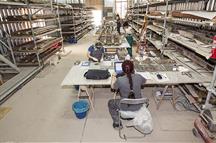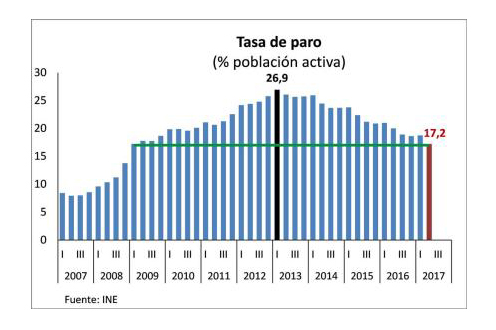Unemployment falls by all-time record of 340,700 in second quarter and annual job creation increases to 2.8%
News - 2017.7.27
According to data published by the Spanish National Statistics Institute (INE), the number of unemployed fell by 340,700 in the second quarter of the year. This is an all-time record since the Labour Force Survey (Spanish acronym: EPA) began to be published. In the year as a whole, the number of unemployed has fallen by 660,400 (14.4%) and the total number of unemployed has fallen below four million (to 3.91 million). The unemployment rate fell to 17.22%, the lowest since early 2009 and almost three points lower than a year ago. Employment rose by 375,000 jobs in the quarter and by 512,300 in the year as a whole, which reflects a year-on-year rate increase of over half a point to 2.8%. All of the employment created in the quarter is full-time and the majority is in the private sector. The number of people in work rose to 18.81 million, the highest figure since 2010.
The figures from the Labour Force Survey reflect the dynamic nature of the Spanish economy, the growth of which surpassed 3% in the first part of the year. It is worth noting the record fall in unemployment for any quarter of the year since the Labour Force Survey began to be published and the increasing pace of job creation. These results reflect major progress towards the goal of returning to the labour market figures posted by Spain before the crisis. The Government of Spain forecasts that, at the end of 2019, the number of people in work will be over 20 million and that the unemployment rate will fall to 11% the following year. Of the more than 3.5 million jobs lost during the crisis, almost 2 million have been recovered (1.86 million), the number of unemployed has fallen by 2.4 million and the unemployment rate has fallen by almost ten points since the all-time high posted in the first quarter of 2013.
 Ministerio de Educación, Cultura y DeporteIn the second quarter of the year, the number of unemployed fell by 340,700, compared with a fall of 216,700 a year ago. It is falling in all sectors, but especially in services (144,000 fewer unemployed) partly due to the fact that Easter fell in April this year. The number of long-term unemployed has also fallen (142,900 people who lost their job over a year ago) and the number of first-time job-seekers rose by 9,100. Over the last 12 months, unemployment fell by 660,400 (14.4% less, compared with 11.2% in the previous quarter). The number of unemployed who lost their job over one year ago fell by 426,100 and the number of first-time job-seekers fell by 59,000.
Ministerio de Educación, Cultura y DeporteIn the second quarter of the year, the number of unemployed fell by 340,700, compared with a fall of 216,700 a year ago. It is falling in all sectors, but especially in services (144,000 fewer unemployed) partly due to the fact that Easter fell in April this year. The number of long-term unemployed has also fallen (142,900 people who lost their job over a year ago) and the number of first-time job-seekers rose by 9,100. Over the last 12 months, unemployment fell by 660,400 (14.4% less, compared with 11.2% in the previous quarter). The number of unemployed who lost their job over one year ago fell by 426,100 and the number of first-time job-seekers fell by 59,000.
The number of people in work rose by 375,000 in the second quarter, compared with an increase of 271,400 a year ago. This was mostly concentrated in the private sector and are full-time jobs, with temporary (255,900 salaried employees) and permanent (93,600) contracts, and in all sectors excluding farming, especially services. In annual terms, the pace of job creation rose by half a point to 2.8%, with 512,300 new jobs. Almost all of them are in the private sector (98.3%), with full-time jobs (443,300 more) accounting for more than part-time jobs (69,000 more) and with more temporary (299,700) than permanent (202,800) contracts. The temporary employment rate stands at 26.81%, more than one point higher than a year ago.
The number of households where all members of a working age are unemployed improved both in the quarter and in the last year. In the second quarter, this figure fell by 117,100 to 1.28 million; the lowest since the fourth quarter of 2009. In turn, the number of households where all members of a working age are employed increased by 269,200 to 10.1 million. In the last year, the number of households with at least one member of a working age where all members of a working age are unemployed fell by 216,200, while those in which all members of a working age are in work rose by 439,000.





